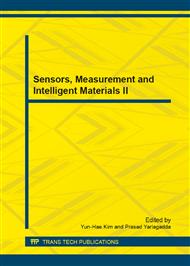p.1235
p.1240
p.1246
p.1253
p.1257
p.1262
p.1266
p.1270
p.1275
Study on Novel Relaxor Ferroelectric Single Crystal PMNT/Epoxy Composite
Abstract:
Use relaxor ferroelectric single crystals PMNT as piezoelectric phase, epoxy resin as a non-piezoelectric phase material, take the cutting - filling method fabricated piezoelectric composite. Its structure character is achieved 1-3 type piezoelectric composites and piezoelectric crystal substrate composite again inseries by the integration, the composite horizontal and vertical bracket to be supported by piezoelectric crystal frame, it has a good impact resistance and affected by changes in ambient temperature characteristics. This composite material both has the advantages of 1-3 type composites, and has stable mechanical and thermal properties. Based on R.E.Newnhams series-parallel theory, combined with the structural characteristics of this composite, given the formula of piezoelectric composites density, piezoelectric constant, and dielectric constant. Fabricated the PMNT / epoxy composites and piezoelectric PZT / epoxy piezoelectric composite materials samples, which have the same scale, the same structural parameters. The experimental results show that, the piezoelectric composite test parameter values match theoretical calculations. The PMNT/epoxy composite has batter function than PZT/epoxy composite.
Info:
Periodical:
Pages:
1257-1261
Citation:
Online since:
December 2013
Authors:
Price:
Сopyright:
© 2014 Trans Tech Publications Ltd. All Rights Reserved
Share:
Citation:


